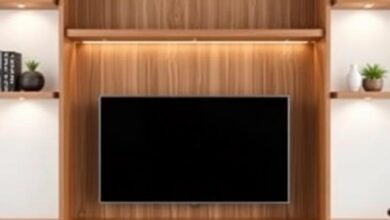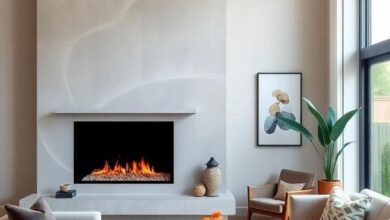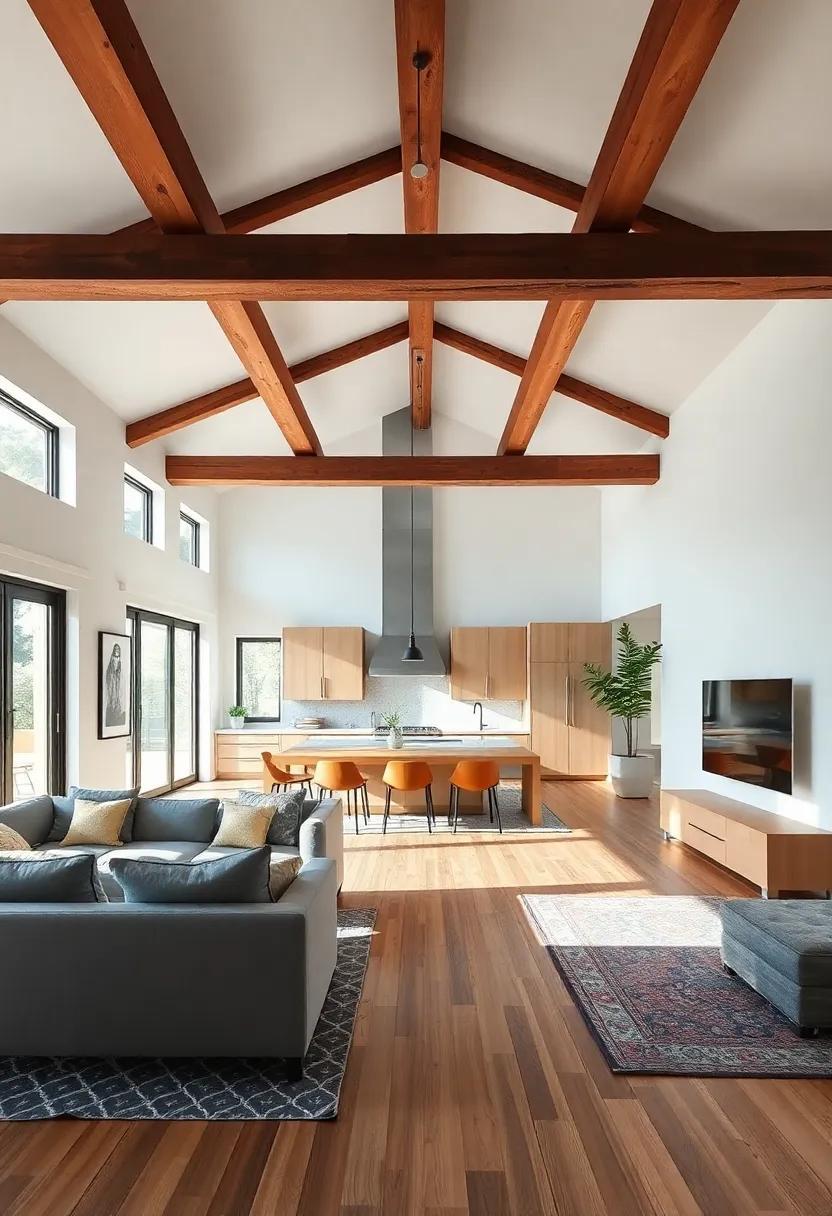
Embracing Space: The Beauty of Open Concept Living with Exposed Beams
In the realm of interior design,the concept of open living has transcended mere trendiness to become a chosen lifestyle for many. As homes evolve into versatile spaces that foster both connection and creativity,one of the most striking features that has emerged is the allure of exposed beams. These architectural elements not onyl draw the eye upward, enhancing the sense of space, but also serve as a festivity of raw, natural materials that tell a story of craftsmanship and authenticity. In this article, we will explore the beauty of open concept living with exposed beams, uncovering how they harmoniously merge aesthetics with functionality, inviting us to embrace the vastness and warmth of our surroundings. Whether you’re a seasoned design enthusiast or merely curious about the potential of yoru own living space, join us on a journey that redefines home comfort through the lens of openness and elegance.
The Allure of Open Spaces and Their Transformative Power in Interior Design

The surge in popularity of open concept living is not merely a trend; it’s a celebration of freedom, light, and connectivity within a home. When large spaces are unveiled, occupants can experience an invigorating sense of unity and flow. The absence of walls invites natural light to cascade throughout the area,creating an almost ethereal ambiance that highlights the beauty of the architectural design. Exposed beams, acting as the backbone of these expansive spaces, add a rustic charm that contrasts beautifully with modern aesthetics. they evoke a sense of history and authenticity, grounding the design and enhancing the feeling of spaciousness by drawing the eye upward.
Open spaces also foster a dynamic lifestyle, where elements are flexible and adaptable. This encourages a seamless interchange between living, dining, and kitchen areas, promoting an engaging habitat where family and friends can gather without barriers. In such settings,thoughtful decor choices become even more critical. Utilizing color palettes that harmonize and furnishings that resonate with the room’s essence can elevate one’s home into a sanctuary of both style and function.Consideration for furniture arrangements can be framed by these spacious layouts, allowing various zones—work, play, and relaxation—to coexist in harmony. Below is a simple overview of essential design elements to incorporate into open concept spaces:
| Design Element | Purpose |
|---|---|
| Natural Lighting | Enhances openness and warmth |
| Color Palettes | Creates cohesion and invites tranquility |
| Multi-functional Furniture | Maximizes usability of space |
| Defined Zones | Encourages different uses within a singular area |
Dramatic Exposed Beams: A Journey from Traditional to Modern Aesthetics

Throughout history, exposed beams have been a hallmark of architectural design, drawing the eye upward and lending a sense of warmth and charm to spaces. in traditional settings, these structural elements were often masked by drywall or painted over in attempts to create a more polished look. However, modern design has embraced their raw beauty, celebrating the character they bring to a home. The transition from obscured to revealed has allowed homeowners to showcase the natural materials and craftsmanship involved, offering a unique juxtaposition that melds the past with contemporary aesthetics.
Today,the trend of open-concept living paired with these dramatic structures not only redefines spatial interaction but also infuses homes with a sense of personality. By removing walls and allowing light to flood in, beams take on a new importance, acting as both functional and decorative elements. Homeowners are experimenting with various finishes and wood treatments, turning beams into statement pieces. Consider the following benefits of incorporating exposed beams in your living space:
- Architectural Interest: They add depth and dimension to ceilings.
- Warmth and Texture: Natural wood brings an organic feel.
- versatile Styles: Suited for both rustic and modern designs.
- Enhanced Space Perception: They draw the eye upward, creating an illusion of space.
Creating a Harmonious Flow: Connecting Living Areas for Uninterrupted Vibes

In an open-concept living environment, seamless transitions between spaces invite a sense of tranquility and unity. Exposed beams not only add architectural interest but also serve as a visual anchor, guiding the eye from one area to another. by strategically placing furniture to encourage conversation and flow, each room becomes a complement to the next, creating an uninterrupted atmosphere. Harmonizing color palettes and materials throughout the areas helps to tie these spaces together, enhancing the overall aesthetic while maintaining a cozy, inviting feel.
To further enhance the flow, consider employing the following strategies:
- Use area rugs to define spaces while ensuring they coordinate in color and texture.
- Incorporate layered lighting to maintain a consistent mood throughout the areas.
- Choose furniture with an open design to avoid visual barriers.
- Add plants or art that resonate with the entire home’s theme.
By focusing on these details, you’ll create an environment that not only flows beautifully but also promotes well-being, making every moment spent at home feel effortless and connected.
natural Light’s Impact: How Open Concepts Illuminate Spaces and souls
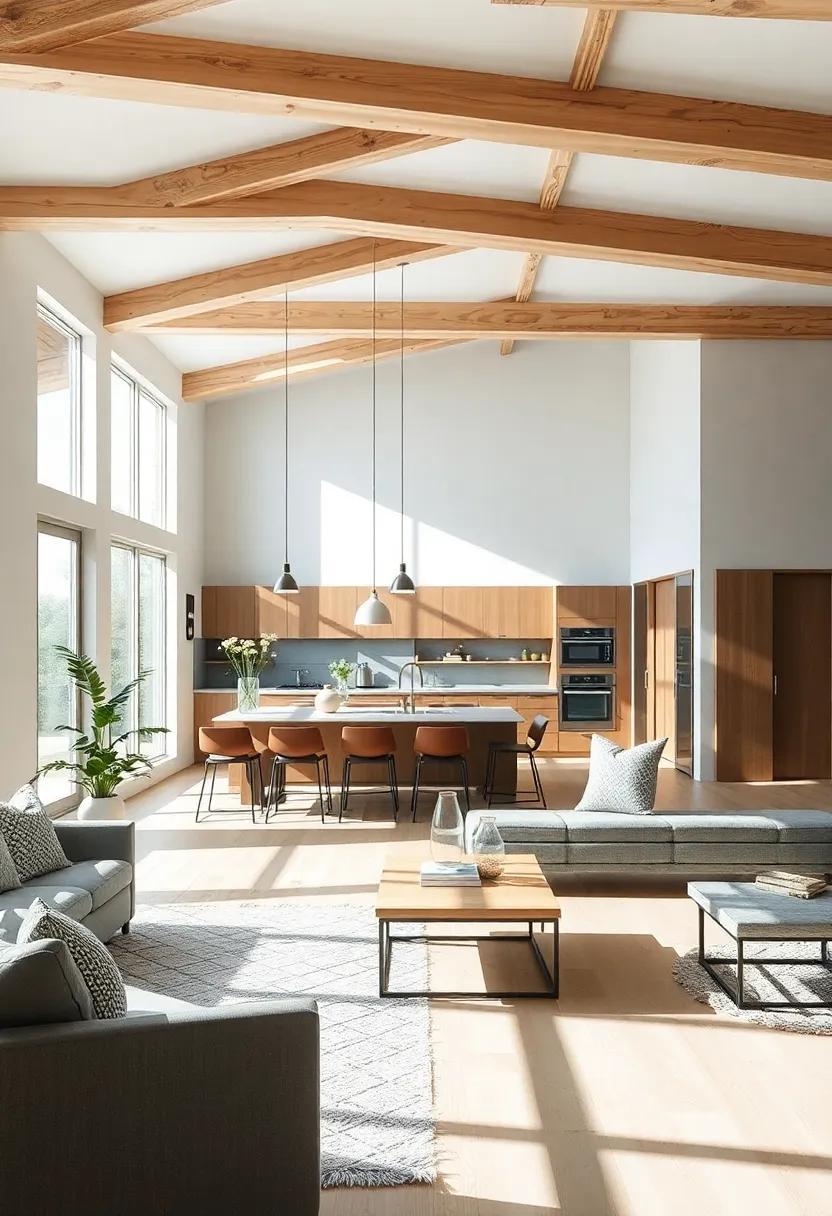
The interplay of natural light within open concept spaces transforms not just the aesthetics, but also the emotional atmosphere of a home. With walls kept to a minimum and expansive areas designed for fluid movement,these spaces invite sunlight to pour in freely,creating an inviting ambiance that energizes inhabitants. Natural light fosters a connection between the indoors and outdoors, enhancing the perception of space and promoting well-being. In such environments, the presence of exposed beams adds a rustic charm, emphasizing verticality and inviting the eye to wander upward, thus increasing the sense of openness and tranquility.
Moreover, as light dances across the surfaces of open living spaces, it accentuates textures and colors, making every corner of the room feel alive. Here’s how embracing natural light can positively influence our experience within these designs:
- Enhanced Mood: Sunlight has been linked to improved mood and energy levels.
- Connection to Nature: Large windows and open layouts forge a bond with the outdoors.
- Welcoming Atmosphere: Luminous spaces invite guests, making them feel at home.
- Visual Expansion: Open spaces appear larger and less constrained.
| Benefits | Description |
|---|---|
| Daylight Savings | Utilizing natural light reduces the need for artificial lighting. |
| Energy Efficiency | Lower electricity bills through reduced energy consumption. |
| Health Boost | Natural light aids in vitamin D production, crucial for health. |
embracing Minimalism: The Art of Choosing Essential Elements in Open Layouts
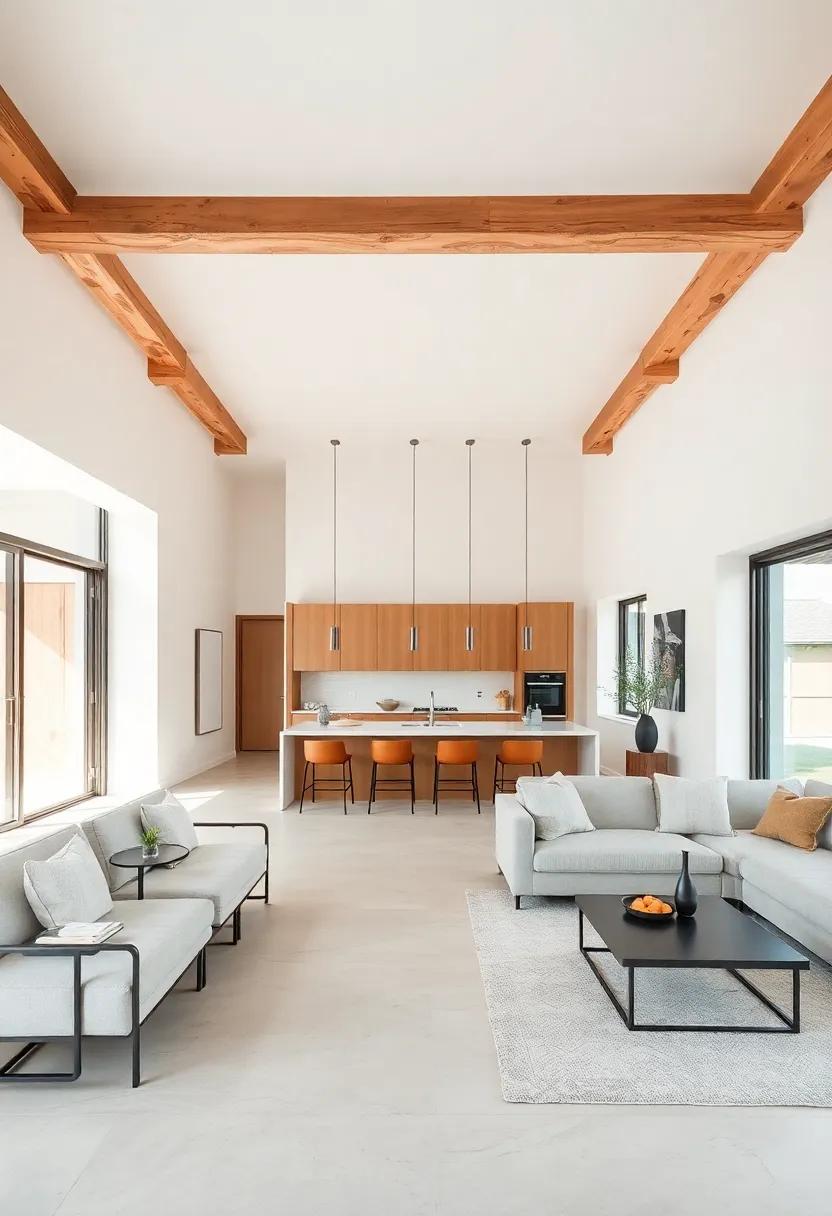
Integrating minimalism into open layouts allows for a serene and uncluttered environment, which is essential for enhancing the overall aesthetic. By selecting only the most vital elements,one transforms a space into a harmonious blend of form and function. This approach not only increases the feeling of spaciousness but also emphasizes the beauty of the exposed beams, giving character and charm to the overall design. Key considerations include:
- color Palette: Choose soft,neutral colors that complement natural light.
- Furniture Selection: Opt for multi-functional pieces that do not overwhelm the space.
- Decorative Elements: Limit decor to a few thoughtfully chosen items that resonate with personal style.
In an open concept environment, the balance between essential and extraneous becomes crucial. This is where thoughtful arrangements come into play, coordinating elements like seating, lighting, and storage in a way that encourages flow. A well-planned layout might resemble the following:
| Element | Purpose |
|---|---|
| Low-profile Sofa | Encourages openness, allowing light to flow. |
| Hanging Lights | Adds visual height and accentuates exposed beams. |
| Minimalist Shelving | Provides storage while maintaining clean lines. |
A Palette of Possibilities: Selecting Colors to Enhance open Living Spaces
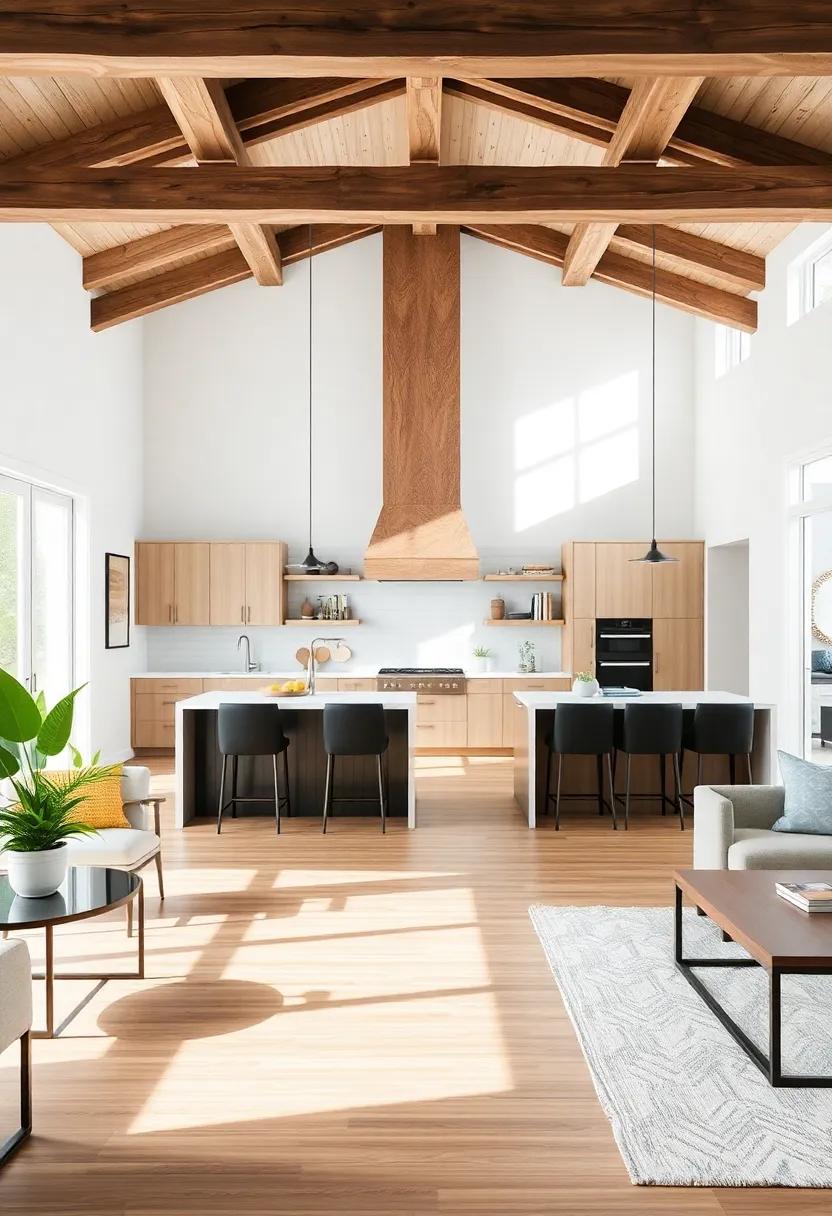
When transforming an open living space, selecting the right colors can beautifully complement the architectural features, such as exposed beams. Consider using a neutral palette as a foundation, allowing beams to stand out while creating an airy feel.colors like soft whites, gentle greys, and beiges can invoke a calming atmosphere and make the space feel larger. To bring warmth and character, incorporate bold accents—think deep navy, forest green, or even fiery terracotta on a feature wall or decor pieces. Pairing these hues harmoniously can highlight the architectural beauty without overwhelming the senses.
to further guide your color selection,keep in mind the purpose of the space and the natural lighting it receives. A well-placed pop of color can energize a family room while a more subdued scheme might make a cozy reading nook in the same area. Consider these combinations:
| Color Pairing | Effect |
|---|---|
| Soft Beige & Olive Green | Warm and inviting, fostering tranquility. |
| White & Dark Blue | Classic and refined,adding depth. |
| Light Gray & Mustard Yellow | Modern and cheerful,creating a lively ambiance. |
by thoughtfully selecting colors, you can create a diverse yet cohesive aesthetic that celebrates the open concept’s versatility. Experiment with swatches and test them in different lighting, as they may appear dramatically different throughout the day. Emphasizing contrasts and harmonies will enable you to craft a space where creativity and comfort coexist seamlessly.
Crafting Cozy Corners: Incorporating Intimate Nooks within Open Areas

Creating intimate nooks within the vast expanse of open areas can transform a house into a sanctuary. By strategically placing comfortable seating and incorporating soft textiles, you can carve out these cozy retreats while maintaining the airy feel of your living space. Consider using sectional sofas or oversized armchairs to define these areas. Layering with plush throws and decorative cushions invites relaxation and adds a personal touch. To further enhance the atmosphere, soft lighting, such as string lights or table lamps, can create a warm glow that beckons you to unwind in your little haven.
Another effective way to establish cozy corners is through the use of natural elements and versatile furniture. Plants, as an example, not only purify the air but also bring life to your nook. Opt for small potted greens or a hanging fern to create a serene vibe. Additionally,consider incorporating furniture pieces with storage to keep the space organized without feeling cluttered.You might even create a mini-library or a workspace in these nooks with a small desk and some bookshelves. Below is a simple table showcasing ideas to outfit your cozy corners:
| Cozy Corner Element | Purpose |
|---|---|
| Bean Bags | Casual seating for relaxation |
| Reading Nook | Quiet space for books |
| Floor Cushions | Flexible, fun seating option |
| Side Tables | Rest drinks or books |
Versatile Furniture Arrangements: making the Most of an Open Floor plan
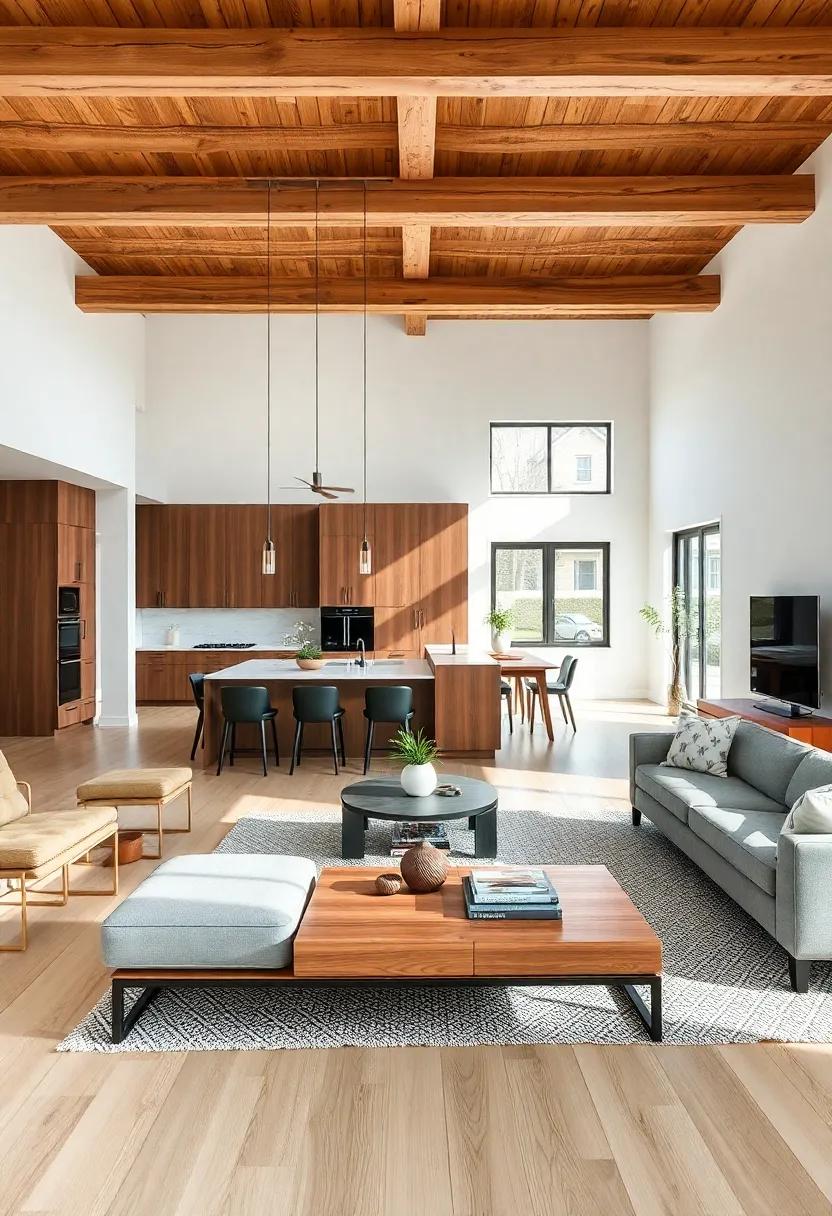
Open floor plans offer a canvas brimming with potential for creative furniture arrangements. To maximize the beauty and functionality of your living space, consider utilizing various zoning techniques that create distinct areas while maintaining an airy flow. A few effective strategies include:
- Area Rugs: Define separate living spaces with beautifully layered rugs that complement the overall aesthetic.
- Furniture Groupings: Arrange sofas and chairs into intimate seating areas conducive to conversation, breaking the expanse of open space.
- Multi-Functional Pieces: Opt for furniture that serves dual purposes, like a coffee table that doubles as a storage unit or an ottoman that can be used for seating.
In addition to creative arrangements, consider the placement of exposed beams, as they draw the eye upward and provide added visual interest. To further enhance the open space, you can incorporate a few decorative elements such as:
| Element | Function |
|---|---|
| plants | add greenery and life, making the space feel inviting. |
| Lighting Fixtures | Utilize statement pieces to create focal points and enhance specific areas. |
| Art Displays | Feature captivating artwork on walls or shelves to add personality. |
Bringing the Outdoors In: Integrating Nature into Open Concept Designs
Transforming an open concept space into a harmonious blend of indoor and outdoor elements can substantially elevate the ambiance of your home. Consider incorporating natural materials such as wood,stone,and metal to create a seamless connection between the interior and exterior. Bringing in large windows or glass doors invites sunlight and fresh air, fostering an inviting atmosphere. Additionally, adding greenery through indoor plants or vertical gardens can enhance the organic feel, while promoting wellness and serenity.Think about including features like:
- Living walls: maximize vertical space with plant life.
- Indoor water features: introduce soothing sounds that mimic nature.
- Natural color palettes: use earthy tones to evoke the outdoors.
To further blur the lines between interior spaces and nature, utilize elements that provide a view of your outdoor surroundings. Incorporating skylights or clerestory windows can fill your open areas with natural light, enhancing the expansive feel of your living space. Another innovative approach is to strategically place outdoor-inspired decor, such as driftwood accents or botanical prints, throughout your open concept design. This not only enhances your space but also creates a calming,nature-infused aesthetic. Here’s a speedy comparison of some elements to consider:
| Design Element | Interior Benefits | Outdoor Connection |
|---|---|---|
| Large Windows | Improves ventilation and brightness | Frames scenic views |
| Natural Textures | Enhances visual interest | Reflects landscapes |
| indoor Tranquility gardens | Promotes relaxation | Brings biodiversity indoors |
Crafting Multi-Functional Spaces: Blending work and Leisure in Open Layouts

In the age of remote work and flexible lifestyles, the ability to seamlessly blend home offices with leisure spaces is more significant than ever.Open layouts encourage creativity by breaking down walls—both literal and figurative—allowing the user to define each area with personal flair. When designing these multi-functional spaces, consider incorporating elements such as:
- Versatile Furniture: Invest in multi-purpose pieces like foldable desks or convertible sofas that adapt to different activities.
- Defined Zones: Use rugs or lighting to visually separate work areas from relaxation spots without closing off the space.
- Natural Light: Maximize sunlight exposure to enhance mood and productivity by positioning workspace near windows.
Moreover, aesthetic details play a vital role in creating an inviting ambiance that balances focus and relaxation. Exposed beams add character to an open layout, serving as striking focal points while supporting the overall structure. Consider incorporating a few design ideas to harmonize your space:
| Feature | Function |
|---|---|
| natural Materials | Add warmth and texture, enhancing emotional comfort. |
| Art and Decor | Inspire creativity and help distinguish between work and leisurely zones. |
| Indoor Plants | Improve air quality while bringing a sense of calmness into the workspace. |
Texture and Contrast: Balancing Soft and Hard Elements in Open Living

In the realm of open concept living, the interplay between soft and hard textures creates a harmonious environment that invites comfort and aesthetic appeal. The juxtaposition of materials can evoke a sense of warmth or drama, transforming the ambiance of a room. To achieve this perfect balance, consider incorporating the following elements:
- Soft Fabrics: Use plush rugs, cushioned sofas, and layered textiles to soften the space.
- Natural Elements: Wood accents, particularly seen in exposed beams, add organic warmth against sleek surfaces.
- Metal Accents: Incorporate metallic finishes in furniture or fixtures to introduce a modern edge.
creating visual contrast involves thoughtful placement and selection of these elements. A stunning way to illustrate this balance is through a carefully curated furniture layout that enhances both softness and structure. The following table showcases the ideal combinations for your living area:
| Soft Elements | Hard Elements |
|---|---|
| Plush throw pillows | Raw wood coffee table |
| Soft cotton curtains | Steel bookshelves |
| Woven baskets | Stone accent wall |
This strategic curation not only enhances visual appeal but also creates a tactile experience that invites interaction, making your open space a true reflection of comfort intertwined with contemporary aesthetics.
Setting the Mood: Lighting Techniques to Accentuate Open Concept Interiors

In an open concept space, where walls disappear and flow takes center stage, lighting becomes a crucial element in creating an inviting atmosphere. The right lighting techniques can enhance the architectural features, such as exposed beams, and draw attention to the unique layout of the area. consider utilizing multiple lighting sources to form a balanced ambiance. Key methods include:
- Layered Lighting: Incorporate a mixture of ambient, task, and accent lighting to add depth and interest.
- Statement Fixtures: Hang bold, oversized pendants or chandeliers to command attention and underscore the airy volume of the space.
- Spotlight Features: Use directional lighting to highlight artwork or architectural details, enhancing the drama of your open layout.
Moreover, the manipulation of color temperature enriches the atmosphere and sets the mood. Warm white light can create a cozy and inviting environment, while cooler hues tend to appear more modern and airy. Embrace dimmers and smart lighting solutions to tailor the chase according to the time of day and occasion. Below is a simple guide to choosing the right lighting color temperature:
| Color Temperature (Kelvin) | Description | Ideal Use |
|---|---|---|
| 2700K – 3000K | Warm white light, cozy and inviting | Living rooms, bedrooms |
| 3000K – 4000K | Neutral white light, versatile | Kitchens, dining areas |
| 4000K – 5000K | Cool white light, modern feel | Office spaces, accent features |
Eclectic Elements: Mixing Styles for an Inviting Open Space Aesthetic

Infusing an open space with a variety of styles creates a vibrant and warm atmosphere. By blending different design elements, you can curate a living area that feels uniquely yours. Consider the following design approaches to create an inviting aesthetic:
- Mixing Textures: Combine materials such as rustic wood, sleek metal, and soft textiles to add depth.
- Contrasting Color Palettes: Use complementary colors to differentiate areas while maintaining a cohesive look.
- Incorporating Artwork: Select pieces that resonate with you, ranging from bold abstract works to framed vintage prints.
To effectively harmonize different styles, focus on both function and form. An eclectic space balances beauty with practicality. Here’s a simple chart to keep track of your design elements:
| Element | Style | Purpose |
|---|---|---|
| Furniture | Mid-century Modern | Comfort & Focus |
| Lighting | Industrial | Ambiance & Style |
| Rugs | Bohemian | Warmth & Color |
By thoughtfully selecting and placing these elements, your open space can reflect a harmonious blend of diverse influences while remaining inviting and functional.
Artful Displays: Curating Personal Touches in Expansive Living Areas
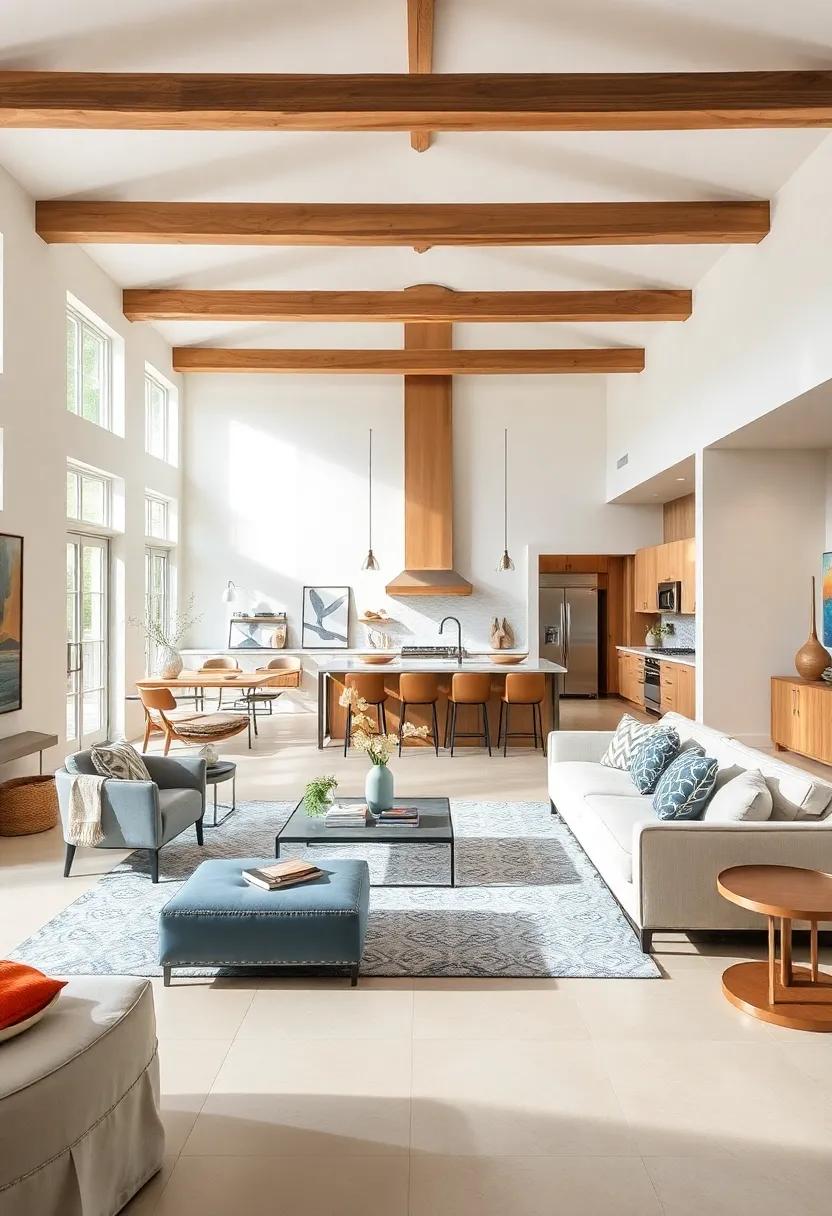
Transforming an expansive living space into a curated sanctuary involves the delicate balance of functionality and artistic expression.With open concept design,the absence of walls invites creativity in how individual elements are displayed. To accentuate the height and structure provided by exposed beams, consider incorporating suspended artwork or hanging planters that draw the eye upward, creating a sense of continuity and fluidity throughout the area. The use of varied textures, such as a woven macramé piece or metal sculptures, can bring depth and intrigue, encouraging visitors to explore every corner of the room.
Color plays an essential role in personalizing large areas—it can evoke feelings, guide the eye, and unite distinct zones. opt for a cohesive palette that draws from the surrounding décor, using artwork or decorative accents to introduce pops of color and visual interest. grouping smaller pieces together in a gallery style can create a focal point while also filling empty wall space effectively. Here are some ideas on how to combine various elements for a striking arrangement:
| Element | Purpose |
|---|---|
| Wall Art | Add personality and color |
| Indoor Plants | Introduce natural elements |
| Textiles | Layer warmth and comfort |
| Sculptures | Create visual interest and height |
Sustainability in Design: Eco-Friendly Choices for Open Concept Homes
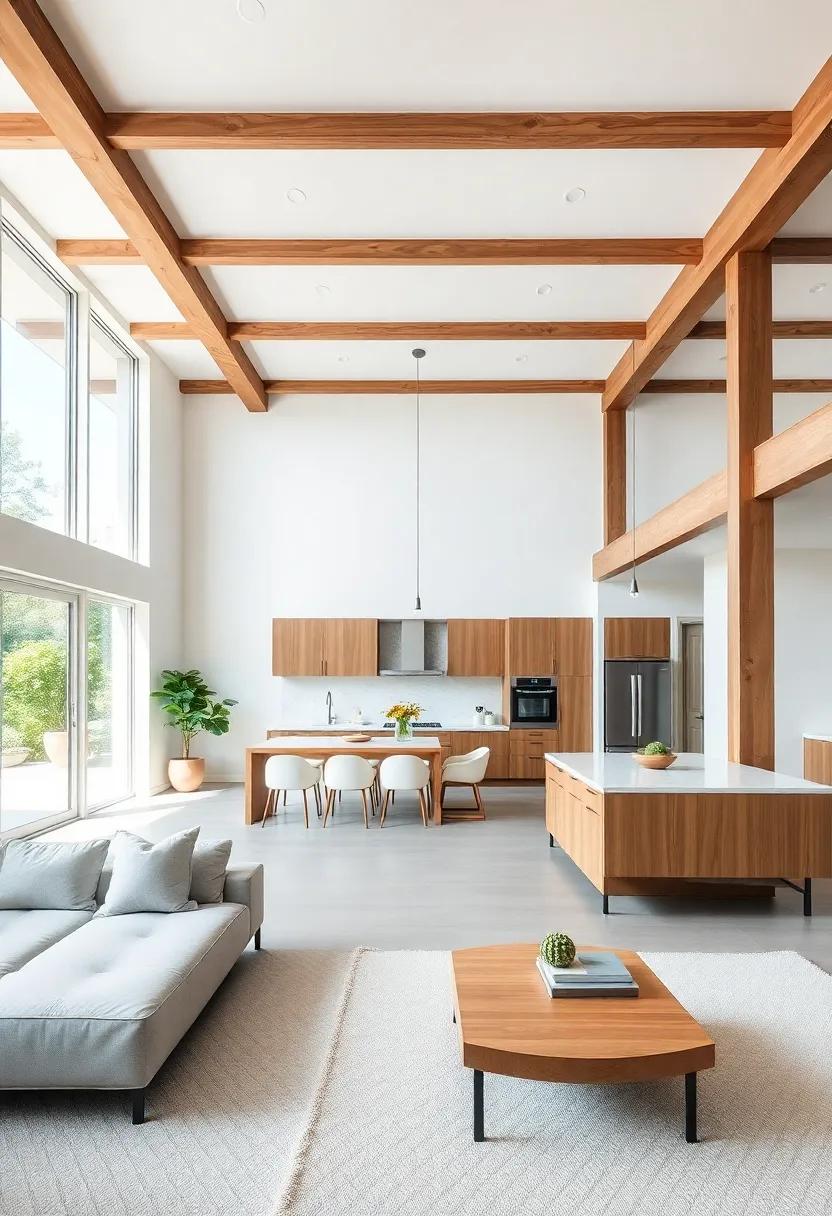
Incorporating eco-friendly choices into the design of open concept homes not only enhances the aesthetic appeal but also contributes to a sustainable future. Choosing materials that are responsibly sourced can greatly reduce your home’s environmental impact. Consider opting for reclaimed wood for those stunning exposed beams, as it not only adds character but also minimizes deforestation. Other sustainable materials to consider include:
- Bamboo: A fast-growing plant that offers durability and versatility.
- Recycled Steel: Ideal for structural elements, it greatly reduces the need for new steel production.
- Low-VOC Paints: Provide a healthier living environment by reducing indoor air pollutants.
Moreover, the integration of energy-efficient systems can dramatically enhance comfort and reduce costs in open concept spaces. From maximizing natural light through innovative window design to installing energy-efficient appliances, every decision counts. Check out this table for some practical, eco-friendly installations that can complement your open layout:
| Feature | Benefits |
|---|---|
| Skylights | Enhance natural light, reducing the need for artificial lighting. |
| Insulation | Improves energy efficiency by maintaining temperature. |
| Solar Panels | Offers renewable energy and can lower electricity bills. |
| Rainwater Harvesting Systems | Conserves water and reduces water bills. |
The Role of Accessories: Focal Points that Define Open Living Areas
Accessories in open living areas serve as vital focal points that enhance the overall aesthetic while providing functionality. These elements, carefully chosen and thoughtfully placed, can draw the eye and create an inviting atmosphere. Some key accessories include:
- Statement Lighting: Unique chandeliers or pendant lights can add drama and warmth,perfectly illuminating the space.
- Textiles: Cushions, throws, and area rugs in varying textures and colors bring comfort and style, helping to define seating areas.
- Artwork: Large-scale pieces can become conversation starters while giving personality to the room.
- Plants: incorporating greenery not only improves air quality but also adds a vibrant touch to the decor.
When selecting accessories, consider how they complement the open concept’s architecture, especially with exposed beams that add a rustic charm. Each accessory should harmonize with elements like color palettes and materials.Below is a simple checklist of accessories paired with design ideas:
| Accessory | Design Idea |
|---|---|
| Wall Mirrors | Reflect light and create the illusion of more space. |
| Layered Rugs | Define separate zones while adding texture. |
| Bookshelves | Showcase personal collections or curated decor pieces. |
| Decorative Trays | Organize small items while adding a touch of style. |
Soundscapes in Architecture: Managing Acoustics in Spacious Environments

in open concept living spaces, the interplay of sound can transform the ambiance and functionality of a home. Exposed beams and high ceilings not only provide visual interest but can also contribute to unique acoustic behaviors. To create harmonious soundscapes, it is indeed vital to understand how sound travels and bounces within expansive areas. Strategically placing soft furnishings,such as rugs and upholstered furniture,can help absorb sound and reduce echo,fostering a more serene environment.Additionally, incorporating sound-absorbing materials in wall designs or artwork can enhance the auditory experience.
Effective management of acoustics is essential in these stunning, airy layouts. Implementing elements that provide both aesthetic appeal and acoustic control can lead to comfortable living. Consider the following techniques:
- Layered Textures: Utilize a mix of textiles, such as curtains, cushions, and wall hangings, to break up sound waves.
- Zoning: Use furniture or decorative screens to create distinct areas that can help contain sound.
- Architectural Features: Incorporate asymmetrical shapes and varied ceiling heights to disrupt sound reflections.
Cultural Influences: Exploring Global Inspirations for Open Layout Designs
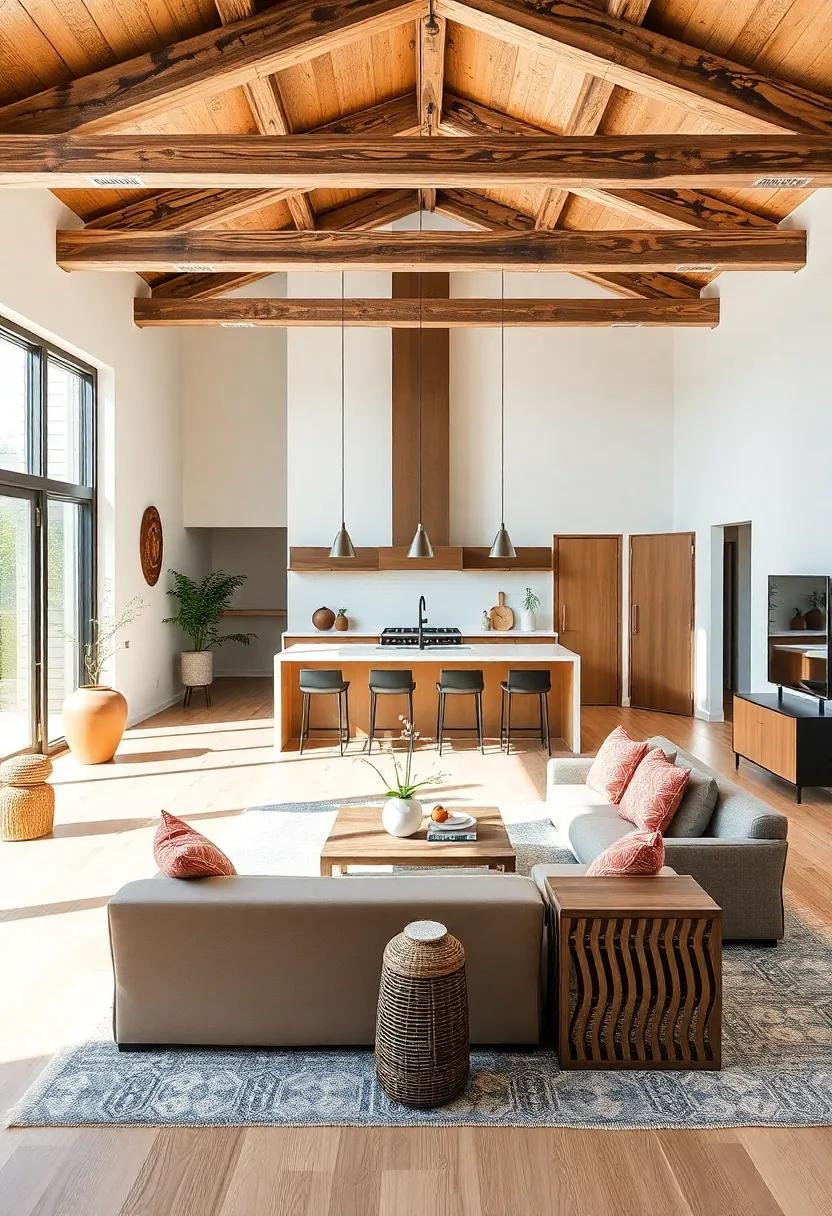
Open layout designs have been significantly shaped by diverse cultural inspirations from around the globe, each contributing unique elements that enhance the concept of spaciousness and connectivity. Such as, Scandinavian minimalism emphasizes simplicity and functionality, utilizing light colors and natural materials to foster an airy atmosphere. On the other hand, Japanese architecture values the use of sliding doors and multifunctional spaces, allowing seamless transitions between indoor and outdoor environments, which invites nature into the home. Some notable influences include:
- Scandinavian Design: Focus on minimalism, light, and nature.
- Japanese Culture: Emphasis on harmony with nature and flexible spaces.
- Mediterranean Aesthetics: Bright colors and open-air designs promote sociability.
- Industrial Style: Celebrates raw materials and urban influences, often featuring exposed beams.
Furthermore, the adaptation of these global influences into modern open concept living allows for personal expression while promoting a sense of community. by incorporating elements such as exposed beams, large windows, and multifunctional furniture, residents can create dynamic environments that blend comfort with style. A comparison of various cultural influences highlights not only their aesthetic differences but also shared themes that resonate in contemporary interiors:
| Culture | Key Features | Design Principles |
|---|---|---|
| Scandinavian | Neutral palettes, natural light | Simplicity, functionality |
| Japanese | Sliding panels, indoor gardens | Connection with nature, minimalism |
| Mediterranean | Open patios, bright tiles | Social interaction, warmth |
| Industrial | brick walls, steel accents | Raw aesthetics, urban vibe |
Mindful Living: Fostering Peace and Serenity in Open Concept Spaces
Open concept living spaces, characterized by their seamless flow and ample natural light, embody a sense of freedom and creativity. The absence of walls invites an intuitive design approach, allowing for versatile layouts that cater to various lifestyles.To enhance this tranquility, consider the incorporation of natural elements and thoughtful decor. Utilize soft textures, such as organic cotton or linen, to create cozy nooks that invite relaxation. Incorporate greenery with potted plants or hanging gardens, which not only purify the air but also promote a feeling of calm and connection to nature.
Another effective way to cultivate peace within these expansive areas is by implementing mindful zoning.define specific areas through furniture arrangements and rug placements,establishing distinct zones for different activities—whether it’s reading,entertaining,or meditating. Below are some suggestions to help you enhance your space:
- Incorporate ambient lighting: Use adjustable floor lamps and soft overhead lighting to create a soothing atmosphere.
- Choose a calming color palette: Opt for soft neutrals and muted tones that evoke serenity.
- Install calming art: hang pieces that inspire tranquility, such as landscapes or abstract designs in soft hues.
| Element | Purpose |
|---|---|
| Natural Light | Enhances mood and reduces stress |
| Indoor Plants | Brings life and purifies the air |
| Textiles | Add warmth and texture |
By intentionally selecting design elements that foster tranquility, you can transform your open concept space into a sanctuary of peace and serenity.Prioritize mindful living through a harmonious blend of aesthetics and functionality, creating a home that not only looks beautiful but also nurtures the soul.
Emotional Connections: Creating Warmth and Comfort in Vast Areas
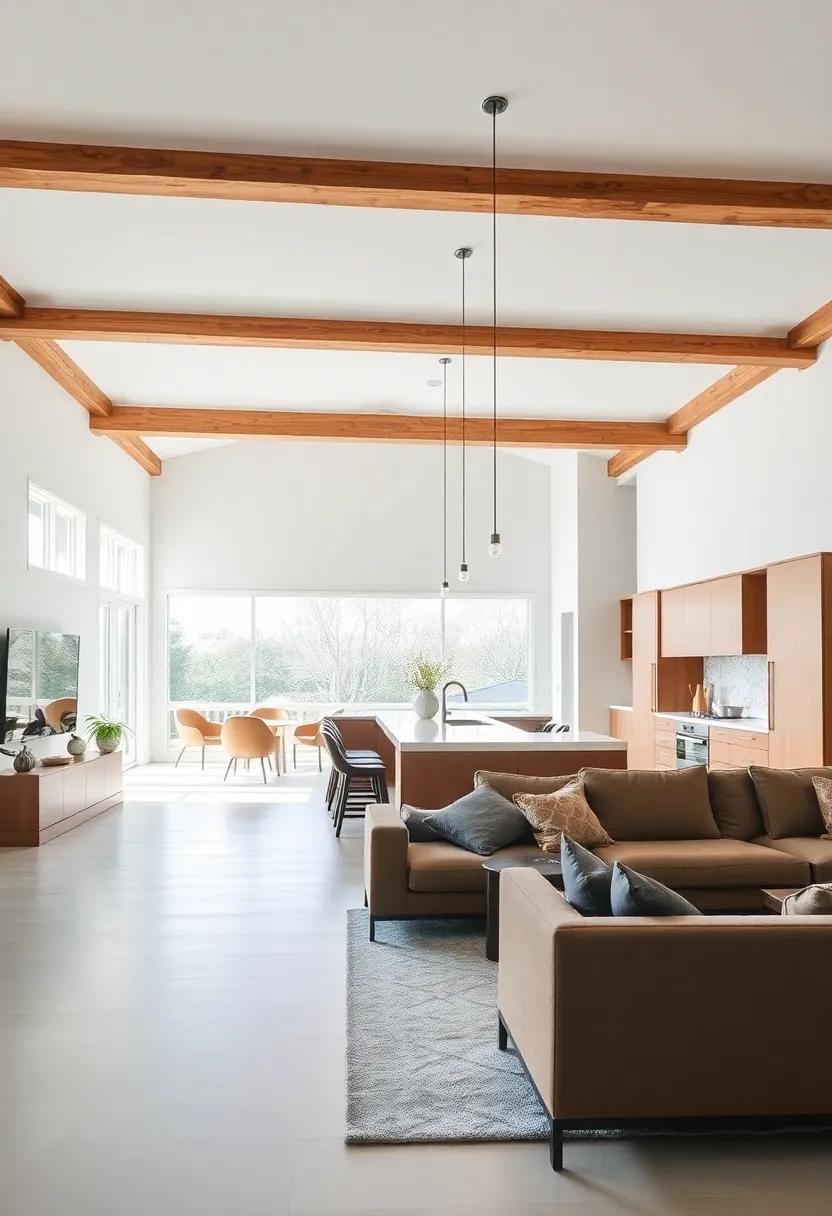
In the realm of open concept living, emotional connections are frequently enough fostered through thoughtful design choices that evoke feelings of warmth and comfort.The interplay of natural materials, like exposed beams and wooden fixtures, serves to invite a sense of familiarity even in expansive spaces. Creating cozy moments in these vast areas is facilitated through various elements, including:
- Soft textiles: Introduce plush cushions and throws to add layers of comfort.
- Personal touches: Incorporate family photos or cherished artwork that reflects personal stories.
- Lighting: use warm, ambient lighting to create inviting nooks.
- Layout: Arrange furniture in conversational groupings to encourage interaction and connection.
To further enhance emotional connections, consider the use of colors and scents that resonate with comfort and tranquility. Earthy tones can ground the space, while the aroma of candles or fresh flowers can evoke cherished memories. additionally, creating designated areas for specific activities allows for a sense of belonging even within larger environments.The careful consideration of these details can bring harmony and a feeling of intimacy, transforming a vast space into a nurturing sanctuary. Here’s a quick overview:
| Element | Impact |
|---|---|
| Textiles | Add warmth and comfort |
| Color | Promotes relaxation and peace |
| Lighting | Creates inviting atmospheres |
| Furniture Layout | encourages conversations and bonds |
Inviting Guests with Grace: Designing Welcoming Entrances in Open Homes

Creating an inviting entrance in an open-concept home is an art form that harmonizes practicality with aesthetic appeal. As guests approach, they should immediately feel a sense of warmth and welcome. Begin by considering elements that enhance sensory engagement, such as:
- Textured Rugs: Soft, natural fibers soothe the feet and ground the space.
- Thoughtful Lighting: Soft, ambient lighting can create a cozy atmosphere that draws guests in.
- Personal Touches: Items like framed photographs or a curated art piece can spark conversations and showcase personality.
Maintaining a seamless flow from the entrance to the main living area can significantly enhance the welcoming experience. The use of exposed beams can extend this warmth, attracting the eye upward and adding depth to the space. Consider incorporating:
| Element | Effect |
|---|---|
| Color Palette | Neutral tones with accents encourage tranquility. |
| Natural Materials | Wood and stone add organic charm. |
| Open Layout | Fosters interaction and movement. |
The Power of Visual Lines: Enhancing depth and Perspective in Interiors
The use of visual lines in design plays a crucial role in shaping the ambiance and spatial experience of an interior environment. Exposed beams,integral to open concept living,serve as more than just structural elements; they are vital in creating a cohesive aesthetic that draws the eye upward. This elevates the ceiling height, producing a feeling of grandeur and spaciousness that can transform ordinary rooms into extraordinary spaces. The distinct lines formed by beams lead the gaze throughout the area, enhancing the sense of depth and making interconnected spaces feel more expansive. By strategically incorporating these elements, designers can influence how light interacts within the space, casting dynamic shadows that further contribute to a layered visual experience.
Along with promoting openness, the lines created by exposed beams can be harmonized with complementary design elements, creating a well-orchestrated flow within a room. Consider the following key aspects that enhance depth and perspective through visual lines:
- Color Contrast: Use different paint shades on walls and beams to emphasize their structure.
- Furniture Arrangement: Place furniture pieces in a way that mirrors the angles of the beams.
- Lighting Design: Utilize both overhead and accent lighting to highlight lines and create dimension.
When incorporated thoughtfully, these strategies can cultivate a harmonious relationship between architectural features and interior décor. They allow homeowners to not only embrace the beauty of open spaces but also experience a profound connection with the environment, promoting comfort and a sense of calm. An atmosphere filled with visual lines beckons inhabitants to explore every corner, enriching both daily living and aesthetic enjoyment.
Future Trends: Innovative Ideas Reshaping Open Concept Living Spaces

As designers and homeowners alike continue to embrace open concept living spaces, innovative ideas are emerging that not only enhance functionality but also elevate aesthetic appeal. one significant trend is the use of biophilic design, which integrates natural elements into living spaces. This approach is characterized by the incorporation of indoor plants, natural light, and materials that evoke the outdoors. Homeowners can achieve a seamless transition between indoor and outdoor environments through the installation of expansive windows and sliding doors that connect to landscaped patios or terraces, creating an feel of broader space. Additionally, the use of sustainable materials like reclaimed wood for exposed beams or bamboo flooring can infuse warmth and character into open layouts, making them both environmentally friendly and inviting.
Another emerging trend in open concept design is the adaptability of zoning through multifunctional furniture and room dividers that maintain openness while offering distinct spaces for various activities. Innovative solutions such as lightweight, collapsible partitions or translucent curtain walls allow residents to adapt their environments according to their needs, fostering a personalized living experience. Moreover, smart home technology is reshaping how we interact with open spaces; from adjustable lighting and automated climate control to integrated sound systems, these advancements create tailored atmospheres that enhance the functionality of communal areas. here are some innovative furniture options revolutionizing this aspect:
| Furniture Type | Features | Benefits |
|---|---|---|
| Convertible Sofa | Transforms from a sofa to a bed | Maximizes space while providing extra functionality |
| Nesting Tables | Compact tables that can be arranged or stored easily | Offers versatility and can adapt to different configurations |
| Folding Screens | Portable dividers that can be moved as needed | Creates privacy without obstructing light and openness |
Insights and Conclusions
As we draw the curtains on our exploration of open concept living adorned with exposed beams, it becomes clear that this design choice transcends mere aesthetics. It invites us to rethink the spaces we inhabit, encouraging a flow of creativity and connection in our daily lives. The interplay of light and shadow, the warmth of natural materials, and the spaciousness foster a sense of freedom that resonates deeply in our modern world.
in embracing this style, we’re not just designing homes; we’re crafting experiences that celebrate both individuality and togetherness. As you consider your own living space, let the beauty of exposed beams inspire you to break down barriers and cultivate an environment that reflects your unique journey. After all, in the open expanse of our homes, we find the potential for growth, togetherness, and a deeper thankfulness for the world around us. So, go ahead—take a breath, look up, and let the beauty of space guide you toward the home of your dreams.
As an Amazon Associate I earn from qualifying purchases.

